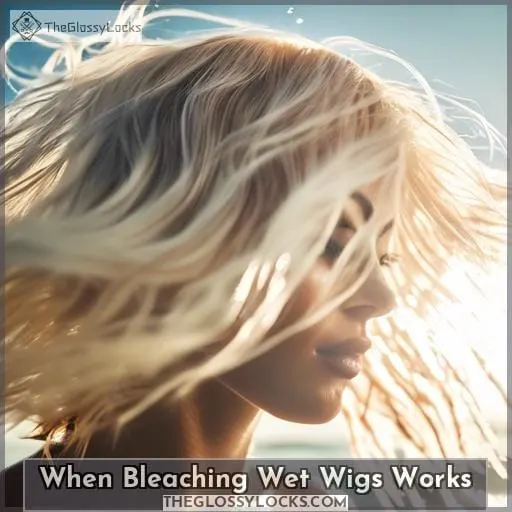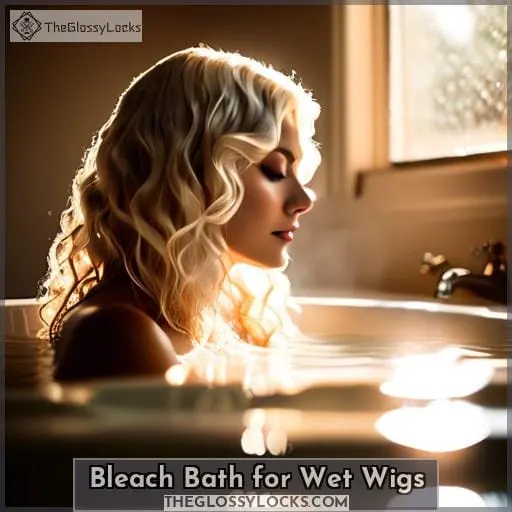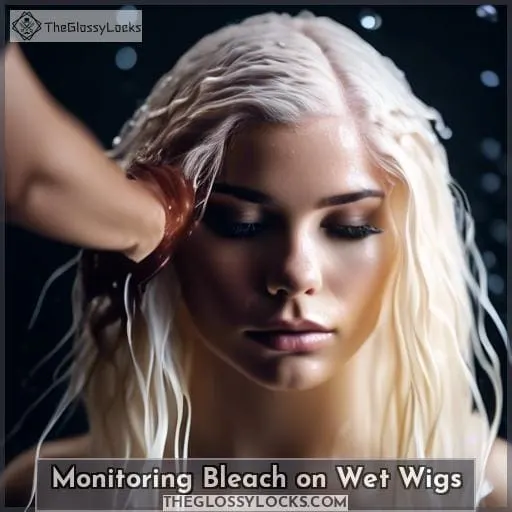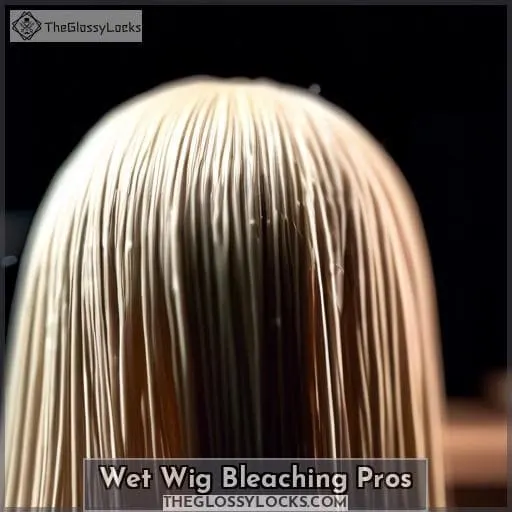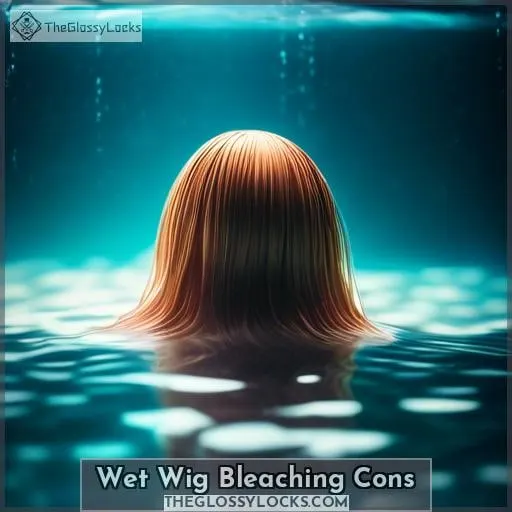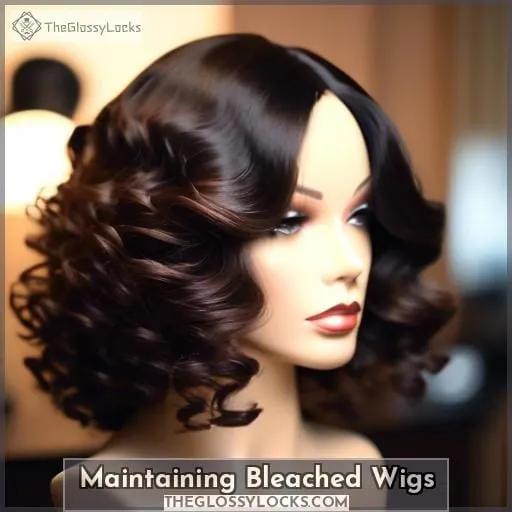This site is supported by our readers. We may earn a commission, at no cost to you, if you purchase through links.
 Curious about the buzz around bleaching wet wigs? You’re not alone. This innovative technique is turning heads, offering a fresh twist on traditional hair lightening. Whether you’re aiming for a subtle color shift or a complete transformation, understanding the ins and outs of wet wig bleaching could be your game-changer.
Curious about the buzz around bleaching wet wigs? You’re not alone. This innovative technique is turning heads, offering a fresh twist on traditional hair lightening. Whether you’re aiming for a subtle color shift or a complete transformation, understanding the ins and outs of wet wig bleaching could be your game-changer.
Dive into the world of bleaching wet wigs with us, where we’ll explore the pros, cons, and essential care tips to keep your wig looking its best.
Yes, you can bleach a wet wig, but it may lead to unpredictable results and diminished bleaching power.
Table Of Contents
Key Takeaways
- Wet wig bleaching can lead to unpredictable results and diminished bleaching power, potentially resulting in streaky outcomes or minimal color change.
- Bleaching a wet wig is not recommended unless you have extensive experience with hair bleaching; seeking professional help is advised for those new to this process.
- Situations where bleaching a wet wig might be considered include aiming for a subtle color change or when applying bleach to dry strands may be too damaging.
- Maintaining a bleached wig requires gentle detangling, storing on a Styrofoam head, regular quality checks, employing color retention techniques, and preventing heat damage.
When Bleaching Wet Wigs Works
When considering whether to bleach a wet wig, it’s important to weigh the potential for subtle color changes against the risks.
If you’re after a minor shift in shade or want to brighten your wig after washing, wet bleaching can work in your favor.
However, always proceed with caution and consider seeking professional help to avoid damaging your wig.
Subtle Color Changes
Considering the need for subtle color changes when bleaching wet wigs, you’ll find that applying bleach to damp hair can indeed create a more understated transformation.
- Color experimentation becomes less risky, inviting you to try new shades.
- Hair damage is minimized, preserving your wig’s integrity.
- Bleaching wet hair offers a gentler approach to altering hues.
- Achieve a subtle color change with nuanced, soft transitions.
- Wet balayage techniques protect hair health while delivering stylish, modern effects.
After Washing
After washing your wig, you’re at an advantage for bleaching it wet since there’s no scalp to worry about irritation from bleach, and the absence of natural oils won’t be a concern.
| Scalp Protection | Color Predictability | Natural Oils |
|---|---|---|
| No issue | More subtle results | No barriers for bleach |
With no scalp oils to serve as a protective barrier, you can apply bleach directly to the fibers without irritation. And without natural oils, the bleach’s potency won’t be diluted, allowing better color predictability for subtle transformations.
Just monitor progress closely to avoid hair damage from overprocessing. For dramatic color makeovers, stick to bleaching dry wigs.
Bleach Bath for Wet Wigs
You can achieve subtler and more even color results when bleaching or dyeing wet wigs by using a bleach or dye bath. Simply mix your bleach or hair dye according to the instructions. Then, fill a sink or basin with warm water and add the mixture.
Submerge the wig completely and allow it to soak for 5-15 minutes, checking frequently for your desired level of lightness or color deposit.
- More even color results
- Lighter shades from subtle dilution effects
- Longer lasting vibrancy and color longevity
- Decreased frizz from extra conditioning
This at-home technique also enhances volume. And you can customize the results through timing, mixing ratios, and incorporating conditioning treatments. For best outcomes when bleaching or coloring wet wigs, repeat these steps as needed.
Monitoring Bleach on Wet Wigs
When bleaching a wet wig, it’s crucial to keep a close eye on the color change.
You’ll need to mix the bleach precisely as the instructions indicate and avoid using heat to prevent damage.
Regular checks will help you achieve the desired lightness without over-processing.
Check Progress Frequently
The process demands your frequent checks given uneven results’ likelihood when bleaching a damp wig. Monitoring is key to achieving color consistency, ensuring timing accuracy, and adjusting bleach concentration as needed.
| Aspect | Why It’s Important |
|---|---|
| Color Consistency | Ensures even bleaching |
| Timing Accuracy | Prevents over-processing |
| Bleach Concentration | Adjusts for desired lift |
| Application Technique | Avoids uneven coverage |
Follow Mixing Instructions
To ensure the effectiveness and safety of the bleaching process on wet wigs, it’s crucial to follow the mixing instructions provided with the bleach product. This will help you achieve the desired results while minimizing the risk of damage to the wig fibers.
- Chemical Safety: Always wear gloves and work in a well-ventilated area.
- Precise Measurement: Use exact ratios for consistent results.
- Product Selection: Opt for quality products like the Feria Hyper Platinum Advanced Lightening System Bleach for optimal lightening.
Avoid Heat
When bleaching a wet wig, it’s crucial to avoid using heat as it can exacerbate damage to the hair fibers.
If you’re using styling tools post-bleach, ensure they’ve temperature control features to minimize heat damage.
For those using the Feria Hyper Platinum Advanced Lightening System bleach, follow the product’s specific guidelines.
Weigh the pros and cons carefully—seeking a haircolor concierge might be wise for personalized advice.
Wet Wig Bleaching Pros
While monitoring the bleaching process on wet wigs is crucial to avoid over-processing, you’ll find that there are several advantages to this method:
- Color preservation – Diluting the bleach helps preserve the hair’s long term hair color health
.
- Healthier strands – Wet hair may better withstand the damaging effects of bleach.
- Faster processing – Color processes faster on damp hair than completely dry hair.
- Easier application – Distributing bleach through wet hair tends to be easier and more even.
The dilution effect allows for more subtle color transformations that require less dye to cover all the strands. This makes it ideal for brightening up ends or subtle all-over lightening in just one session.
However, those seeking dramatic changes may be disappointed with the less vibrant results on soaked strands. Outcomes can also turn out uneven if care isn’t taken to frequently check progress. Still, when done properly, wet wig bleaching can lend itself to smoother color transitions with less damage.
Wet Wig Bleaching Cons
Several drawbacks exist when you bleach a wet wig; most notably, you’ll find that the diluted bleach can lead to less dramatic and potentially uneven results, making the outcome quite unpredictable. The water in the wig fibers dilutes the bleach, which not only diminishes the lifting power but also increases the risk of patchy lightening.
Moreover, the porosity of the wig’s hair can vary, which means some areas might absorb the bleach faster, leading to an uneven color distribution. This inconsistency can be a challenge to correct and might necessitate additional treatments, increasing the damage risk to the wig.
Over-processing is another danger when bleaching wet wigs. Since the bleach processes faster on wet hair, there’s a fine line between achieving the desired lightness and causing irreparable harm.
Here’s a quick reference table to summarize these points:
| Concern | Description | Impact |
|---|---|---|
| Uneven color distribution | Bleach is diluted by water | Patchy appearance |
| Damage risk | Increased with additional treatments | Compromises wig integrity |
| Over-processing danger | Faster processing on wet hair | Potential for severe damage |
Always consider these factors carefully to maintain the health and appearance of your wig.
Tips for Wet Wig Bleaching
When bleaching a wet wig, you’ll use less dye to get more subtle results. The water dilutes the bleach so you don’t need as much product to gently shift the color.
This saves you money on supplies while being kinder to the wig fibers for a naturally radiant transformation.
Less Dye Needed
One can use less dye when bleaching a wet wig, as the water helps to distribute the bleach more evenly, resulting in a more subtle color change. This approach not only champions Color Conservation but also maximizes Dye Efficiency.
By minimizing the amount of chemical needed, you’re engaging in smart Resource Management.
It’s a savvy move for those looking to refine their craft while caring for our planet. Embrace this technique to master the art of wig transformation with minimal chemical use.
More Subtle Results
You’ll get subtler hair color transformations when bleaching a wet wig. The water dilutes the bleach solution, reducing its strength. This technique is perfect for those aiming for a gentle shift rather than a dramatic change.
It aligns with color theory principles. It allows for nuanced color correction while preserving hair integrity. By adjusting the bleach concentration, you can achieve desired hues without compromising the wig’s quality.
Consider bleach alternatives for even gentler effects. This ensures your wig remains vibrant and healthy.
Seek Professional Help
For optimal results when bleaching a wet wig, it’s best to consult with a professional stylist who’s experience with this delicate process. A seasoned expert can provide a thorough color consultation, ensuring the hue you desire is achievable without compromising the integrity of the wig.
They possess the stylist expertise necessary to evaluate the condition of your wig and perform a damage assessment, which is crucial before proceeding with any chemical treatment.
Your stylist will select the most suitable technique and offer product recommendations tailored to your wig’s specific needs. They understand the nuances of working with different wig fibers and can adjust their approach accordingly.
By leveraging their knowledge, you’ll avoid common pitfalls and ensure your wig remains in top condition. Trusting a professional not only safeguards your investment but also guarantees that the end result aligns with your vision for style and sophistication.
Maintaining Bleached Wigs
After bleaching your wig, it’s crucial to adopt a rigorous care routine to preserve its health and color.
- Limit washing to 1-2 times per week with sulfate-free shampoo to retain vibrance
- Apply weekly conditioning treatments to boost moisture and prevent brittle strands
- Always detangle gently with a wide-tooth comb to minimize breakage
- Store wig on a styrofoam mannequin head when not worn to maintain its shape
Implementing diligent Color Retention Techniques, Heat Damage Prevention, UV Protection Methods, and Chemical Exposure Avoidance through quality conditioning, gentle handling, and proper storage will help ensure your bleached wig retains its freshly transformed, salon-quality style for as long as possible.
Regular Quality Assurance Checks on the health of the hair fibers can motivate continued adherence to a rigorous care regimen over time.
Frequently Asked Questions (FAQs)
How long does it take to bleach a wet wig?
Bleaching a wet wig can be a bit of a gamble, but when you’re aiming for that perfect hue, it’s all about timing and technique.
Typically, you’ll want to keep an eye on your wig every 5 to 10 minutes during the process.
The total time can vary, but generally, knots on a wig are bleached within 15-30 minutes.
What kind of bleach should I use when bleaching a wet wig?
Imagine sunlight dancing through honeyed strands as you lighten your wet wig with a gentle bleach, like Milano Care WB – Wigs and Bundles Bleach Powder.
Will bleaching a wet wig damage the wig fibers?
Bleaching a wet wig can indeed damage its fibers, especially if it’s not done with care. The process can weaken the wig’s structure, leading to potential breakage, tangling, and a loss of texture quality.
It’s crucial to approach this with a gentle hand and follow proper techniques to minimize harm.
What’s the best way to rinse out the bleach after bleaching a wet wig?
Like a gentle tide washing away footprints on the sand, rinse your bleached wet wig with lukewarm water until the water runs clear.
Then follow with a nourishing deep conditioner to soothe its newly lightened strands.
How often can I bleach my wet wig before the quality starts to degrade?
Limit bleaching your wet wig to avoid quality degradation.
Ideally, space out sessions by at least 2-3 weeks to prevent dryness and tangling.
This ensures your wig remains luscious and vibrant.
Conclusion
Imagine transforming your wig from a dull blonde to a vibrant platinum while it’s still damp from a wash.
Yes, you can bleach a wet wig, and this technique could be your secret weapon for achieving dreamy color transitions.
By following our guide, you’ll navigate the pros and cons, ensuring your wig remains in top condition.
Dive in, experiment safely, and watch your style evolve.

